
55 minute read
The Levelling up white paper conference with CULS LP&DF
from ACANews June 2022
by brianwaters1
Account of Forum meeting on 8th March jointly with Cambridge University Land Society and the ACA. Full minute by James Mitchell also at planninginlondon.com > LP&DF
Moderators
Brian Waters (BW) Paul Finch (PF)
Speakers
Joanna Averley (JA) Professor Robert Adam (RA) Roy Pinnock (RP) Janice Morphet (JM) Dr. Nicholas Falk (NF) Dr Steven Norris (SN) Max Tolley (MT) David Bainbridge (DB) Rob McNicol (RM) Paul Finch (PF)
Joanna Averley (Department of Levelling Up - Chief Planning Officer)
• JA is privileged to be chief planning within government and be able to bring outside practice into government • JA started by reflecting back on the year and the mobilisation of the planning system to address current challenges of the world. in summer ,July, an updated policy within the national planning policy framework has been lunched reflecting on the role of design and place making and strengthen the NPPF in terms of addressing some of the issues regarding the protection and enhancement of the environment, journey to net 0 and the how to address climate adaptation. • National Model Design Code has been launched. It encapsulates and advocates how the process of design and spatial planning delivers good outcomes on the environment, quality of places, buildings, and spaces, and on the delivery of all type of infrastructure. • National Model Design Code - sets the menu of issues and opportunities (page 7, part 2). It clearly describes the issues that we consistently should consider when designing and planning at different scales.It is about the importance and value of context as starting position of any design and planning; movement promoting active travel; nature - how to protect it and enhance it; build form, identity ; public space; homes and buildings space standards, uses, resources energy heat, and lifespan management. Many people use page 7 as a checklist and to start conversations with communities and local authorities about what is important to them and adapt the local policies.
Joanna Averley Joanna Averley
JA talked about digital transformation and the potential of big data and how it has huge capabilities to help cut short the planning process by mobilising the data to help decision making. There is a huge investing to mobilise the data capability and bringing digital to make things easier, clearer, faster with less prone to errors causing delays.
Meeting held on Tuesday 8th March hosted by Dentons
Chairman
Brian Waters
Speakers
Speakers: Joanna Averley, The Government Chief Planning Office: Keynote Roy Pinnock, Partner, Dentons UK & Middle East LLP Professor Robert Adam Professor Janice Morphet, UCL Dr Nicholas Faulk, Executive Director, URBED Trust Steve Norris, Lambert Smith Hampton Max Tolley, England Policy Officer, RTPI Nicholas Bosetti, Centre for London David Bainbridge, Partner, Savills Sanmi Adegoke, Rehoboth Property International Dr Riette Oosthuizen, Head of Planning, HTA Design Moderator, White Paper Discussion & Q&A: Paul Finch, Thomasin Renshaw, Development Director, Pocket Living Rob McNicol, Acting London Plan Team Manager GLA Paul Finch OBE, Director World Festival of Architecture, & Co-Editor PiL Participants:
Mike Adams Adams Infrastructure Planning Ltd Arthur Bessis Student, University of Cambridge Ian Blacker Planning Director, Tetra Tech Planning Andrew Catto President - ACA, Andrew Catto Architects Sue Chadwick Strategic Planning Advisor, Pinsent Masons LLP Winnie Che MPhil student | MRICS, University of Cambridge Benjamin Choo Student, University of Cambridge Victoria Collett Senior Development Manager, Legal & General Suburban BTR Jan Derlatka Student, University of Cambridge Kassie Foot Rolfe Judd Ltd Melanie Hern, COO ACA Daniel Formston Residential Research Analyst, Savills

People are anticipating change in terms of adaptation and improvements of the planning system.
Reflecting on the Levelling Up White Paper - it is a new department for levelling up housing and communities, having a set of consideration - health disparities, the quality of houses, economic outcomes, delivery of environment and access public spaces.
The process of change in the planning system has to include all the parties form private and public sector and be more clear collectively of the role planning system. Questions: Victoria (Legal General Suburban Build To Rent): We have a big scheme in West Sussex that has been held up because of water neutrality issue. We are not the only one having this issue and it seems to come up a lot lately. I was wandering how are you going to balance the delivery of new homes with the strategic level environmental issues?
JA: We have close working relationship with DEFRA and Environmental Agency and Natural England and it is a pressing and important issue for all us and it is an active policy area that we are looking at the moment. Not being able to disclose more at the moment.
Trebicon (Associate Director Cities) dealing with master planning for over 20 years I found myself increasingly disenchanted by the process of master planning - it is too linear, takes too long especially now when the context is quickly changing and so much disruption happening. Do you think that the master planning is still fit for purpose?
JA: Take same principle as design - it is a process. It should deal with uncertainty. A masterplan should be adaptable to change. A good example is fixed bits of infrastructure that enables things to happen in and around them. You will never embark in a project without having a plan and the masterplan is a three dimensional of a plan and it should look a bit into
Annual Planning and Levelling Up-Date 2pm Tuesday 8th March 2022
At Dentons, One Fleet Place EC4M 7WS


KEYNOTE The government chief planning officer
Joanna Averley
New focus on employment land Nicolas Bosetti Centre for London
Roy Pinnock, Dentons
Professor Robert Adam The role of the Office for Place
WHITE PAPER & PLANNING Housing - a growing role for councils Professor Janice Morphet UCL
What to do with the High Street? Dr Nicholas Falk URBED
Delivering the renaissance of our towns and shopping centres Steve Norris Lambert Smith Hampton
RTPI Proposals for Planning Reform Max Tolley England Policy Officer RTPI Green Belt release – only by appeal? David Bainbridge Savills
White Paper panel discussion with Q&A Sanmi Adegoke, Rehoboth Property International, Dr Riette Oosthuizen, head of planning at HTA Design, Thomasin Renshaw, development director at Pocket Living and speakers –Moderator: Lee Mallett
IMPLEMENTING THE LONDON PLAN
Rob McNicol
Acting London Plan Team Manager, GLA
THE WIND-UP
Paul Finch
NETWORKING AND DRINKS
PLEASE BOOK HERE: https://www.culandsoc.com/events/annual-planning-and-levelling-up-date/
Christopher Francis Director, West & Partners Vendela Gambill Student, University of Cambridge Beth Gascoyne Partner, Cripps Pemberton Greenish LLP Thomas Gibson Account Executive, Redwood Consulting Tom Haworth Design Manager, Tide Construction Ltd Abigail Heraty Planning Manager, Amro Real Estate Partners Daniel Hill Student, University of Cambridge Garth Holden Analyst, Brydell Partners Roddy Houston Chairman, CULS Commercial Property Agency Government Property Agency, Cabinet Office Bairun Huang Student, University of Cambridge Patrick Inglis Architect, IBLA Shayan Keyhan-rad MD, Investre Limited Avanes Khachaturov Student, University of Cambridge Oliver Lazarus Architect, Urban Mesh Nicholas Lindsey Student, University of Cambridge Jacobus Lombard Principal, Deon Lombard Architects Maber-Jones Student, University of Cambridge Ian Marcus OBE Senior Advisor, Eastdil Secured President, Cambridge University Land Society Gregory Markes Senior Planner, Quod Julie Mc Laughlin Associate Director, Tetra Tech Planning Lucy Minyo Richard Morton Director, Richard Morton Architects Ltd Peter Murray Curator-in-Chief, New London Architecture Louisa Nie Grosvenor Alice Perkins Student, University of Cambridge Richard Pia Account Director, Camargue David Primost Managing Director West Heath Properties GmbH & Co KG Jane Qin Student, University of Cambridge Yao Qu Student, University of Cambridge Zaid Randeree Student, University of Cambridge Quinten Richardson Judith Ryser Director, CityScope Europe Judy Slater Consultant Martin Stepanek Student, University of Cambridge Emilios Tsavelles Senior Planning Manager, SAV Group Jerry Unsworth Independent Planning Consultant, Unsworth Planning George Vasdekys Partner, Salisbury Jones Planning Brian Waters Principal, The Boisot Waters Cohen Partnership Myriam Waters Robert Waugh Associate Director - Asset Management LocatED Property Ltd Salvador Widdicombe Student, Cambridge University Mark Willingale Architect, Willingale Associates Shuqi Zhang Head of Business Development, Country Garden Holdings Company Ltd Yangfan Zheng Student, University of Cambridge

the future and allow for changes.
A question about spatial planning. The process of planning for future and future generation is lost in planning. Is it enough to plan at district planning - or should it be a higher tier of plan making than district planning?
JA: To recognise the ability and flexibility of the local authority to do joint planning and do not stop at boundaries.
Indicating the balance has shifted that regulatory is the predominantly but it is important. It is enable by a strong plan to protect and enhance what is important now. We have a strong agenda on beauty, environment, quality, place making, housing, infrastructure etc.
Professor Robert Adam (Robert Adam Architectural Consultancy Ltd) Office for Place
The presentation is a series of joint up parts that the Office of Place is part of. It began with building beautiful commission /living with beauty policy proposition. -Series of policy preposition made up a matrix for how things proceed. -National design guide. Running in parallel. -June 2021, National Model Design Code
RA showed a page from the National Model Design Code showing a cascade level of codes covering different scales and having different roles in different places.
On the right it is an extract showing the Design Code Process and the key part of this process is consultation. -National Planning Policy Framework - 128 is referring to the design guides that provide a local framework for creating beautiful and distinctive places with consistent and high quality standard of design at different scales.
The Office for Place has been lunched in July, 2021. Visions: • Catalysing fundamental change within and across all levels of government to support the creation and stewardship of popular, healthy, beautiful and sustainable places. • Help neighbourhoods, communities and public servants on their behalf routinely to ask for and to deliver both new places and manage existing places to be beautiful, popular and sustainable • Support with pragmatic expertise public sector planners and the British design & development industries to the best ‘place-makers’ in the world aided by improving UK and international data on happiness, health, popularity and sustainability.
The Transition Board- has politicians, developers, planners, highway engineers, architects, and so on, to provide a reasonable cross section to help the guide.
Piece of research - showed that the lost trust in the system. (2% trust developers to act honestly on large developments; 7% trust councils to make the right decision on large developments.)
Parasitic development and vicious circle - it is a negative view of how the planning system works.
Houses not places (Unclear quality asks from the planning system) - Opposition to new homes- Constrained allocation of new homes - High land cost and pressure on build costs.
A virtuous circle of regenerative development- Places not houses is the key issue - Less opposition to new homes- Democracy brought forward to plan making - Simple and predictable regulations. A degree of speculations is removed from land prices.
Office for Place: five principles
• Empirical • Empowering communities • Flexible • Networked • Digital
Office for Place: five activities -
• Researching; • Supporting and accrediting • Training • Celebrating • Advising
Office for Place: Researching and Supporting
Centred around the issues of code.
RA highlighted that there is a confusion between what a code is and what a guidance is. A code is a binary choice - yes or no. A guidance is an advice to follow but you don’t have to.
Universally we have the issue of lack of resources and skill and the hopes are by advancing a coding process before you get to land sale and start designing there will be more clarity.
One key issues if you codify in advance it should reflect on land value.
The more clarity one has the more accurate land value will be.
Pathfinding - the institutional structure of the Office for Place still have to be structured.
Creating a link between what a community would like to see within policy and how can be built into the coding system.
Labour intensive and difficult thing to achieve - these links are the utmost importance. Production of codes and the final product has to be transparent.
Questions:
Paul Finch: One of the most difficult things about this exercise is to define what ‘beautiful’ means and I wonder if it is a smart idea to inject the word into policy?
RA: I made exactly the same point - it is the best you can do with a particular community. It is not static. Producing codes does not produce good design but it stops excess of bad design.
!"#$%&&#"'(#)%"*'+,-.'!/0 (#)%"*'+,-.'+"1/2*%1*3"-4' 5#6&34*-617'8*, !""#$%&"'(&)*+$%
/0123%42456%20%789
:;%%%<=>%021%?@5A4B 7;%%%CD=E2F@1%?@5A4B%62E566B G;%%%H=@%I12F5?6B%I2IA651%0213J?5=@K%E2K@= L;%%%)2E56D=@%4M@%!"#$%&"'()%*+'(,+-$.&(/%*+ NO%%%(@13D4%5%05=4%415E>%021%?@5A4B :P;%$Q=A1@%@Q021E@3@Q4 ::;%$Q=A1@%IA?6DE%@QR5R@3@Q4%D=%SDK@T%K@@I%5QK% @516B :U;%$3I2S@1%E233AQD4D@= U7;%(12324@%I65QQDQR%@VE@66@QE@ U8;%(12324@%5%E2332Q%AQK@1=45QKDQR%20%I65E@ UL;%!41@536DQ@%I65QQDQR%5QK%=MD04%1@=2A1E@=%0123% 77;%,@JKD=E2F@1%EDFDE%I1DK@%DQ%51EMD4@E4A1@
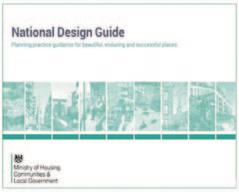

!"#$ &' ()'*+,- ./0+.1. 23/)+45 /6'14%,-7+89 -0(-24/4+'97 /4%/9 -/)35 74/8-: /33 3'2/3 (3/99+98 /14;')+4+-7 7;'13, ()-(/)- ,-7+89 81+,-7 ') 2',-7 2'97+74-94%<+4;%4;- ()+92+(3-7 7-4%'14%+9 4;- =/4+'9/3 >-7+89 ?1+,- /9, =/4+'9/3 @',-3 >-7+89 A',-: /9, <;+2; )-B3-24%3'2/3 2;/)/24-) /9, ,-7+89 ()-B-)-92-7$ >-7+89 81+,-7 /9, 2',-7 ()'*+,- / 3'2/3 B)/.-<')C B') 2)-/4+98 6-/14+B13 /9, ,+74+924+*- (3/2-7 <+4; / 2'97+74-94%/9, ;+8; D1/3+45 74/9,/), 'B ,-7+89$ &;-+) 8-'8)/(;+2 2'*-)/8-: 3-*-3 'B ,-4/+3 /9, ,-8)-- 'B ()-72)+(4+'9 7;'13, 64/+3')-,%4'%4;- 2+)21.74/92-7 /9, 72/3- 'B 2;/98- +9 -/2; (3/2-: /9, 7;'13, /33'< / 71+4/63- ,-8)-- 'B */)+-45
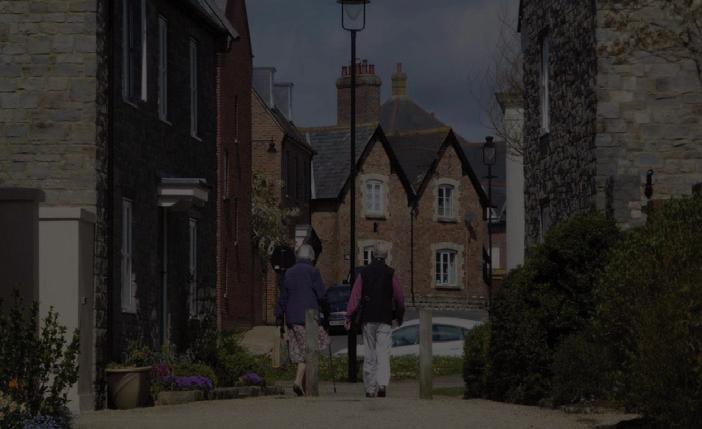
!"#"$%&'(%)*"#*+,)&,%+'(-)&%)(,&)#.+#($$/)&012+"#1++34+''"/&%&),561)#)7)#%1)8 '(82)5,",%(&/(2$8%+#)9"&#)61(%%1)8.&/32)("%&."$(/3%+#).",)61(%%1)8.&/3"0$8:!"# 7&,&+/&,%+; 4(%($8,)(."/3(')/%($41(/0)6&%1&/(/3(4#+,,($$$)7)$,+.0+7)#/')/%5%1) 3)7)$+*')/%&/3",%#85%1)*$(//&/0,8,%)'(/3,+4&)%8%+,"**+#%%1)4#)(%&+/(/3 ,%)6(#3,1&*+.*+*"$(#51)($%1852)("%&."$(/3,",%(&/(2$)*$(4),< 1)$*/)&012+"#1++3,54+''"/&%&),(/3*"2$&4,)#7(/%,+/%1))1($.#+"%&/)$8%+(,.+#(/3%+3)$&7)#2+%1/)6*$(4),(/3'(/(0))=&,%&/0*$(4),%+2)2)("%&."$5*+*"$(#5 1)($%18(/3,",%(&/(2$)<(/3 ,"**+#%6&%1*#(0'(%&4)=*)#%&,)*"2$&4,)4%+#*$(//)#,(/3%1)>#&%&,13),&0/(/3 3)7)$+*')/%&/3",%#&),%+2)%1)2),% ? &/%1)6+#$3(&3)328&'*#+7&/0@A (/3&/%)#/(%&+/($3(%(+/1(**&/),,51)($%15*+*"$(#&%8(/3,",%(&/(2&$&%8:

.%&/+0%&*'12&2(312&2/%&1512%6 -%.%+($/#01
!"#$%+..%. &'()%$*+,$-.$%+/%-$$,$,"% 0"#$%7%+.4(% &'()%1$213$%3+4$%5%-$$,%5% &'$6$%)'$7%162/1$6" 8"#$%7+5 /4+33/%(-,%.(1(.+)+$/%29%::+;%<=>/%:++;% .2??@-+)7%5%:+++;%,$/+A-%-$)&264%)2%+-926?% 2@6%92.@/" B"#$%#2%06#"8 3$(,%6$/12-/+C+3+)+$/" D"#$%2%"#0% C@/+-$//%?2,$3%21)+2-/" 3455'(6#01 ?&A$$(%2#6#01
!"#$%5#*'6 ,$/+A-%.2,$%.6$()+2-"% 0"#$%&+33%$(%+6%&+02 7+0+1%&+&9#6%&:+(; 926% $E.$33$-.$%&+)'%F=G/%926%,$/+A-%.2,$/"% 8"#$% 5%A@+,(-.$"% #$%(,*+/$%2-%'2&%)2%6@-%1@C3+.%C(332)/%(-,% *+/@(3/%16$9$6$-.$%/@6*$7/" B"#$%./+(%&<%.6 5(+$6#$%&&+,$37" D"#$%=(#6%&>'<&2%.$(#56#'0.&?&9)@. 926%13(.$% ?(4$6/H%/)6()$A+.%13(--$6/H%'+A'&(7/% 299+.+(3/%(-,%2)'$6/"



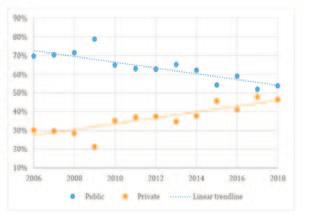

,- !"#$!% &'(')*+'"$%!*%,-!% .*/'$!)0%*/%),"1'% &'(')*+2'/!$ 34%!"#$!%-*#/-5)$% !*%2,6'%!.'%"51.!% &'-5$5*/%*/%),"1'% &'(')*+2'/!$ LEFT and ABOVE: Robert Adam’s slides BELOW: Roy Pinnock’s slides

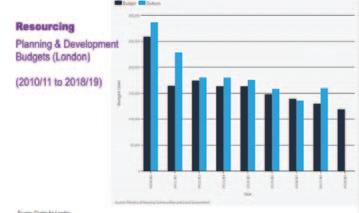
Local Plan and Policy Resource Reductions in expenditure on planning
(2009-10 to 2017-18)

!""#$%&"'(&)*+$%,&"#-%&.(#/$#.*%0 !""#$%&"'(&
Source: RTPI analysis of MHCLG data on Local authority revenue expenditure and financing
Talent
Shift to the private sector
(2006 to 2018)
'()%*%+," '()-.#*%/0 !"#$%&"# 1#2.-*3#4 5%0%2,"
9%/%+($:#34
8(+#3#34 67-#/#34
Source: ONS Annual Population Survey, filtered by SOC10M = 2432 (Planners). Result for each year is based on period ending September that year
Roy Pinnock CULS March 2022 - Planners and Levellers
RP started with an overview of topics covered in 2019 about simplifying and speeding up planning, and strategic planning. In 2020, about the white eight but beauty, planning and London plan. • We are still talking about reform and basic delivery. Working without the adequate resources. • If we value planning - are we investing in it? It is telling us that we are not. If the system is asked to be more and more - it is an enabler, it is there to facilitate things to achieve macro political bills of levelling up and achieve positive change rather than simply regulate the spatial distribution of activity.
Resourcing Planning & Development Budgets (London) 2010/2011 to 2017-2018
Data shows that it has been a decline of almost 60%. The decline in funding over period and the actual expenditure just shows how unrealistic the expectation are.
The demand for planning services is outstripping the supply.
On the policy side - a reduction in expenditure is not showing the changes in subsidy. Bigger reduction in subsidy it goes into the planning system.
We should not blame the system too much as it is a resourcing issue ultimately.
Talent - Shift to the private sector (2006 to 2018)
It shows that the public body do not necessarily have the actual capacity to deal with demands.
Talent - UK Pipeland - DO Minimum
The slide shows a series of pie charts from EuroStat European Labour Force Survey showing the different selected build environment occupations in different countries.
Looking at the distribution of planners - in UK there are many surveyors (44%) and not as many planners (16%) in comparison to Netherlands where there are less surveyors (9%) and more planners (45%).
There will be a significant drop off in the availability of planning talent.
The legal system is overload due to chronic repeated performance.If we are resourcing the real issues we can tackle those over the 5-10 years.
Questions:
Steve: How do you make planning ‘sexy’ and how would you get schools to persuade students that planning is the right career for them.
RP: If you have the window open just look at the view - that is about the contested space between planning with the economic need and design . Planning can be easy to be enticing to people and hugely exciting. >>>
>>>
Janice Morphet (Professor at UCL)
Involved in the research on the role of the local authorities re-energising their responsibility for the production and delivery of social housing.
What does LUWP (Levelling Up White Paper) say about housing context: -It applies to all the UK - it is thin in terms of references as you go to the content.
In Scotland, Wales and Northern Ireland the local authority would have a budget to deliver social housing and there is no right to buy. Perhaps England should be levelling up with the other 3 administrations and go back to having no rights to buy and each council having a budget.
Research -in London boroughs the mayor has the responsibility of housing funding - and he created means by which each borough can bid for a 5 years program to deliver housing. The boroughs - 32% are building houses considering the land constraint.
If you look outside London, local authorities are ‘stuck’ with Homes England, not having the 5 year program, no security and ability to rest on a project program. -Housing Quality is a key focus - the pandemic has shown a light in councils on the quality of the properties that they own and the kinds of properties which they are negotiation trough planning consents.
Quality is absolutely key. • Levelling Up is a tool to reduce housing pressure in the SE - Janice response is ‘good luck’ with that.There is a housing pressure everywhere.
On the NE the council are actually building executive homes to maintain having a mixed society. In other parts of the country there are building home for rent for young graduates to keep them in the area after graduation. - Housing is regarded as physical capital and also contributor to social capital
It is not invested only in new places. What about the places that are not going to change that much? Should we be retrofitting, as RIBA said, our suburban area? They need to change as well and planning and housing can make some contribution to that. • Housing key in Level Up through productivity - not only thinking of modern method of construction, it is also about the relationship between home and work, thinking about commuting, distances, costs of housing etc. Our economy is important in our relationship with housing.
More details points of LUWP - most of these we have yet to see any action to how these will be implemented. • Giving renters secure path to ownership - ambition but we have not seen how this will happen • Combining housing with regeneration
As part of the research a 100% survey has been taken - which is in the public domain and it is accessible for every council in England. The survey looked
What does the LUWP say about housing? context
•Applies across the UK •Housing quality key focus particularly in private and social rented homes •LU is a tool to reduce housing pressure in the
SE •Housing regarded as physical capital and also a contributor to social capital •Housing key contributor to community pride in place •Housing key in LU through productivity
What does LUWP say about housing? proposals
•Giving renters secure path to ownership •Combining housing within regeneration •Build more affordable social housing •Launch drive for housing quality and conditions •Greater role for Homes England to support
Combined Authority mayors and devolved funding for housing •Unlock pension fund assets for housing •Planning key means of delivering housing agenda
Meeting housing need
•‘The UK Government will also increase the amount of social housing available over time to provide the most affordable housing to those who need it.
This will include reviewing how to support councils to deliver greater numbers of council homes, alongside Housing Associations.’ (p224) •National Landlord Register •Retrofitting for energy needs •Tackle anti-social behaviour
at what housing they are building, companies, joined venture partners, what are they doing with housing associations.
Last year we found that a high number of councils engage and support housing trough regeneration schemes which are undertaken largely by the private sector.
What recognition they are getting for this kind of contribution which is really coming out of a diminishing resource. We need to find more about this but the affordable houses are more secure basis for regeneration than retail or commercial - this is a very significant factor and the way the economy is moving at the moment. • Build more affordable social housing
Interest to see how the budget is going to be changed and how to get the 5 years programme in the rest of England. • Launch drive for housing quality and conditions - We have no information about this. • Greater role for Homes England to support Combined Authority mayors and devolved funding for housing • Unlock Pension Fund assets for housing. - this is a new idea but if the government were to implement the International Financial Reporting Standards - which is what every other OECD country uses as a basis for capital investment then we would be able to see more asset based investment. • Planning key means of delivering housing agenda. If we want developers and those with consensus to build out, you cannot rely on local authority to force this to happen, they just do not have the power. • Meeting housing needs - the UK Government will also increase the amount of social housing Available over time to provide the most affordable housing for those who need it. Scotland, Wales and Northern Ireland is doing that because the budgets have just been released and the number is going up, while England does not have the same kind of budget for the local authorities to be able to do that. • National Landlord Register
Scotland - each local authorities would have become a letting agent to take on private sector dwellings in order to tackle homelessness. This is not the case in England. • Retrofitting for energy needs - same budget as the new build. We cannot do both so how can we manage that. • Tackle anti- social behaviour - A good example of this is the Exeter City Living - has been building to passive house standards for over 10 years. An independent assessment of how is it going it was found that domestic violence has been reduced and anti social behaviour gone down. There is less financial pressure domestically on bills. • There are some good point in the Levelling Up White Paper however the proof will be in the delivery and we have not seen this yet.
Dr. Nicholas Falk (Executive Director, URBED Trust) What to do with the high street? A call for action now
• Dr NF wrote a series of reports for town centres - including vital and viable town centres. • He is an economist, urbanist,& strategic planner
In the presentation he gives a view of what White Paper should say.
Start on report of Smart Cities Capitalising on the Digital Revolution. • need action - vacant rates began to rise after the financial crash. The Town centres are different now and there is a spatial blindness amongst economists, which causes us to generalise when we need to be specific. • London West End - probably has been transformed more than most by the loss of students, tourists and office workers. We have to change the act in town centres and think about the demographic profile. • Great contribution - that the White paper 25
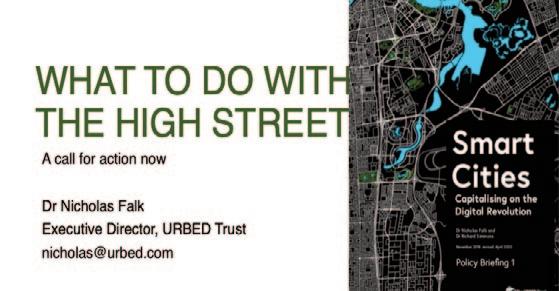




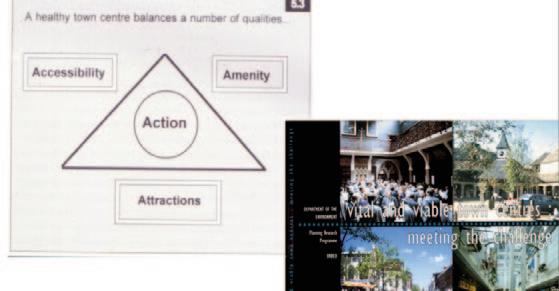
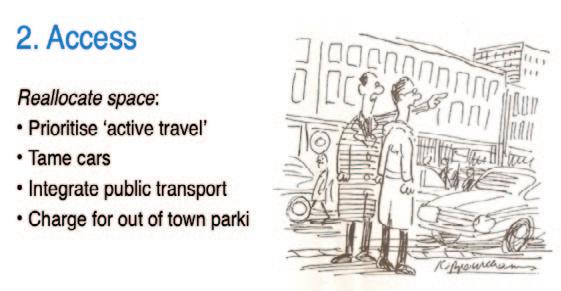
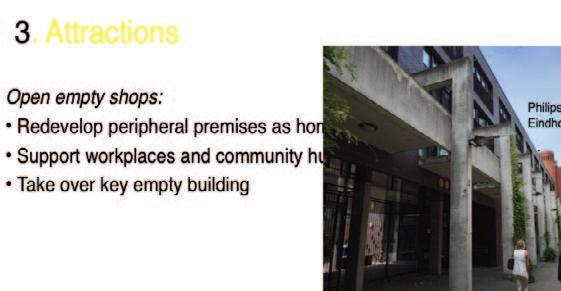


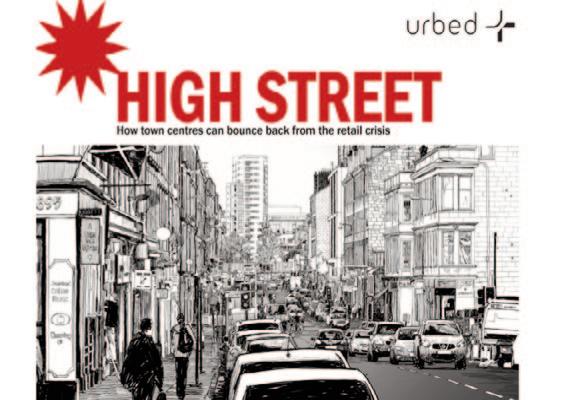
>>> makes is that recognises is a vicious circle.
NF wrote a report in 1972 pointing out the same thing. We discovered there are 7 types of capitals that are leading to persistently worst outcomes so productivity, quality of life, place, and leadership all down because of changes in these different types of capital.
In regards of town centre - a simple diagram of 3 or 4 ‘A’ (accessibility, amenity, attractions, action) was used in the Vital and Viable Town Centre Report -
1 Action
Made the most of GIS to set priorities; look at the catchment area; identify disadvantaged areas and highlight clusters. Use data that already exists.
2. Access
To make easier to get into centre by prioritising ‘active travel’. To tame cars - reducing the speed of cars and integrate the public transport. Charge for out of town parking.
3.Attractions
Reopen empty shops: -Redevelop peripheral premises as homes -Support workplaces and community hubs -Take over key building. Once a building has been empty for a while , it has to be taken over by another body.
4. Amenity
Promote special place
That means looking at clusters and waterfronts; festival and campaigns to animate people, environmental upgrades, reignite civic pride cross-woking with local community groups.
5. Agency
Re-empower the local authorities. If were to write the White Papers NF would start by recasting parking charges and property taxes- tackling the issues of money; rethink what town centres are for; set up partnerships and pilot projects; share lessons example - joint Academy of Urbanism
Dr Steven Norris (National Head of Planning, Development & Regeneration) How can we deliver the renaissance of our towns and shopping centres?
-SN started by introducing himself • SN is been advising on Town Centre Regeneration for 30 years. • SW gave an overview to what Lambert Smith Hampton does: advise all stages of regeneration lifecycle from early sight of planning appraisal through to visioning master planning and assembly and delivery and management. As well as producing various research and viewpoints from the impact of the pandemic on the hotel commercial retail and logistic sectors. • Researched which is coming out the end of this month is about how we can deliver the renaissance of our towns and shopping centres. • Research is based on a survey conducted on 2018 about Brexit, and 2020 at the height of the pandemic. Good cross section of representation. • Respondents: Profile and Roles - as it can be seen from the graphs there are predominant private sector (75%) and it is consistent over the years the survey was done.
Top 5 Key challenges that affects the town centre. -Business rate (53.9% in 2021) -growth of online shopping (51.5% in 2021) -oversupply of retail floor space (36.1% in 2021) -rise in home working/decline in office employment (25.7% in 2021) -lack of up to date plan and strategies for town centres (22.0% in 2021)
One of the impacts of the pandemic had is the rise of online shopping - The graph is showing the internet sales as a percentage of total retail sales ( ratio) (%). In January 2021 online shopping went up to nearly 38%. Forecasters predict it could rise to as much as 50% by the end of the decade.
The growth of online sales align with the cost and debts of physical retailers. The impacts of pandemic has been more widespread than just on retail - the rise of food delivery means that we can eat and drink at home, the choices on Sky, Netflix etc, means we can also have the cinema experience at home without going to cinema. We are also getting used to be working from home and attending conferences and meetings from home having a significant impact on office space and also on the Town Centres.
The challenge that we face is how to bring people back into town centres.
What percentage of the current town centre retail space will be to repurpose/redevelop in order to create more viable and sustainable town centres. National vacancy rates are 16% and the rates for shopping centres is 20% - A number of community centres have benefited from the pandemic. This is because people have been forced to stay local so they had to rely more on local shop services and facilities. • Question now are what is the future of workspace and what will it look and feel like in the future. Many practices are reviewing and downsizing their workspace because of flexible and hybrid working.These could benefit some of the communities centres located outside of London and the UK larger regional cities. • Asking which 2 main interventions for towns and shopping centres will most help to address climate change over the next decade? Most of the responses were improvements to public transport networks. Reinforcing the point of walkable neighbourhood. • What measures do you think will help to build greater resilience in out town centres over the next 5 years, helping to ensure their overall vitality and viability? The top section include redevelop and repurpose shopping centres and or vacant retail space; develop more homes in town centres; flexible turnover rents and/or lease structures for occupiers and improvements to environment/public realm/green spaces which is vital for tackling the climate crisis but also for health and wellbeing. • How the town centres will look and feel like in the next 5 years. The result of the research provides some insights: many shops cafes and restaurants are viewed as vitally important to the city. Our towns need to adapt and diversify and provide more flexible space that and respond to market trends. • Identifying the challenges and opportunities facing the town regeneration/development.The research identify the joint ventures of public-private partnerships remained the preferred investment. The local authorities are more critical than ever in delivering town centre regeneration projects. One of the key reasons is because the have access to different funding sources and grants. • Funding and delivery - Future High Street Fund; Town Deal Fund,; Levelling Up Fund • What happens when government funding run dry. Both public and private sector. Have to find different , more creative ways of investing in town centres. • There is a survey showing that successful and sustainable regeneration of town centres require strong leadership and governance. • There is a renewed optimism for the future of our towns and high streets. Retail is not an answer to the challenges facing town centres. The researchers identify a number of key themes and interventions that will help build resilience:
Financial policy interventions that need to create a level playing field between physical and online retailing. These include a review of traditional rental models and online tax and more support for independent businesses.
A need to rethink and repurpose the role and function of many towns high streets and shopping centres by planning management and curation of buildings and spaces. We need to provide more quality home and affordable homes, adapt and diversity town centres and build back resilience, restore civic pride and create attractive place and build up on walkable cities.
Max Tolley (RTPI England Policy Officer) RTPI proposals for Planning Reform
Produced a policy paper last year in March - ‘Planning for a better future’ and has five proposals for planning reform which is underpin by two core statements: • The planning must respond to new challenges and opportunities supporting the economic recovery while tackling inequalities, accelerating 27
Top Five Key Challenges 2021 2020 Change in Rank
Business rates 53.9% 49.5%
Growth of online shopping 51.5% 69.7%
Oversupply of retail floor space 36.1% 43.1%
Rise in home working / decline in office employment 25.7% 27.2%
Lack of up-to-date plans and strategies for town centres 22.0% 15.0%
BUILDING BACK TOWN CENTRE
“What measures/initiatives do you think will help to build greater resilience in our RESILIENCE town centres over the next five years, helping to ensure their overall vitality and viability?”
!"#$%#&'%"()*&+,-./0&1&+"/2$%#&'#0%("&+$"%)#"'3/+'
!(4/''/()&)#5&2/'/()'6&'%"$%#*/#'&$)7&4$'%#"+.$)'&8("&%(5)&0#)%"#'
9#7,0#7&0$"&+$":/)*&0('%'&$)71("&%3#&/)%"(7,0;()&(8&8"##&+$":/)*
<"(2/7#&)#5&,'#'&=#>*>&+"(8#''/()$.&'#"2/0#'6&0$"#6&?%)#''&#%0>@
A4+"(2#4#)%'&%(&#)2/"()4#)%&1&+,-./0&"#$.4&1&*"##)&'+$0#'
B.#C/-.#&%,")(2#" "#)%'&$)71("&.#$'#&'%",0%,"#'&8("&(00,+/#"'
6% 4% 3%
4%
8%
10% 41% All parties Local government Property owners/ investors National government Regional government Town Centre Managers/ BIDs Local communities Local Enterprise Partnerships Occupiers Mayors Other
21%
•!'#(%& •!"#$%& RENEWED OPTIMISM FOR THE
FUTURE OF OUR TOWNS AND HIGH STREETS
50%
2021 2020
38%
25%
13%
D#2#.(+&4("#&3(4#'&/)&%(5)&0#)%"#'
9#7#2#.(+&1&"#+,"+('#&'3(++/)*&0#)%"#'&$)71("&2$0$)%&"#%$/.&'+$0#
CRITICAL MIX OF USES
“Over the next five years, what do you think will be the optimum CRITICAL MIX of uses/ services that will best help underpin successful centres/ high streets and viable regeneration/ development initiatives?
0%
Very Optimistic Optimistic About the same Pessimistic Very Pessimistic TOWARDS A ROADMAP TO RECOVERY
!"#$%#&$&'#(#'&)'$*+,-&.+#'/0 12+'/&"#3+'+#,!#0 '$*&%4#&.52,/$%+5,3&.5"&"#!5(#"*
Rank 2021: TOP MIX OF USES/SERVICES 2021 Change from last year
1 Food & beverage (e.g. restaurants, cafes, etc.) 70.5% 2 Non-food retail (e.g. fashion, household goods etc.) 43.6% 3 Food/ grocery stores 34.4% 4 Low cost/ flexible retail space 29.9% 5 Culture & heritage 29.5% 6 Public realm/ open spaces/ parks 29.0% 7 Street markets 29.0%
8 Pop-up shops/ meanwhile uses 20.7% 9 Free town centre car parking 20.3% 10 New Homes - Private Rented Sector/ Build-to-Rent 19.9%
FUNDING & DELIVERY
• !"#"$%&'()*&+#$%%#&!",-&!"#$%&''&()"*$++",(-)./0" • ./0,&1%23&!",-&!"#123"%&''&()"*$+$",(-)./0"!"#$%&'(#!)(#*+*!,&-,./(#(0"-"1&0# %(2(-(%,!&"-#"3#!"4-*#!"#$(/&'(%#/"-2#!(%1#(0"-"1&0#,-$#5%"$+0!&'&!6#2%"4!)2" • 4%5%33(,)&67&!",-&!"#425%)"(678")79,":";7<8.2
REFORM BUSINESS RATES
REFORM RENT / LEASE MODELS ONLINE v PHYSICAL
SUPPORT INDEPENDENT
RETAILERS
ABOVE: Dr Steven Norris’s slides
progress towards 0 CO2 and building resilience • Recognise the importance of reinvigorated properly resource planning system and be visionary in our response. Five proposals: • Plan making - taking a long term view and considering all relevant factors, not making piecemeal one off decisions • Development Management - assessing how planning offices improve schemes through negotiation with applicants. • Green Growth Boards- bringing together local authorities and key stakeholders to tackle the challenges that a region faces • Planning for Climate Change and Nature Recovery - transitions to a 0CO2 society and enabling environmentally friendly choices in everything from energy to transport • Planning With and For People - to thrive it must be driven by consent
Levelling up
Levelling Up and Regeneration Bill anticipated in the Queen’s speech later this year.
White Paper Proposals included: -Reviewing how local authorities can be supported to deliver more council homes -Extending the role of the High StreetsTask Force -Reforming developer contributions -Increasing engagement with infrastructure providers in plan making -Improving cycling and walking with Active Travel England.
RTPI and Town and Country Planning Association guidance on climate change published in 2021: • Explains the need to design to cut carbon by promoting energy efficiency and sustainable transport • 29 case studies of best practice • Shows how local authorities and communities can help tackle the climate crisis • Highlights the key of the planning system Transport Moving on a research that was produced in 2020 for the RTPI showed that: • Transport emits 35.5% of all emissions in an average local authority. • Explored how different places can achieve 80% reductions in surface planning emission by 2030. • Identify some barriers to delivery and possible solutions: • More effective leadership • Better integration across public policy • Greater support for policy and decision makers at the local level • Making active, public and shared mobility more accessible and affordable than private modes • Promote behavioural shifts away from car-depended lifestyles. >>>
DIVERSE & FLEXIBLE REPURPOSE & REPOSITION
SUSTAINABL E & GREEN CONVENIENT & ACCESSIBLE
EVENTS& CONNECT PLACEMAKING LEADERSHIP & GOVERNANCE BUILD LOCAL COMMUNITY RESILIENCE
PREPARE INVESTMENT PLANS TO SUPPORT TOWNS & BUSINESSES
ALIGN WITH NATIONAL / LOCAL STRATEGIES & FUNDING SOURCES
Development Management
Assessing how planning offices improve schemes through negotiation with applicants.
Green Growth Boards
Bringing together local authorities and key stakeholders to tackle the challenges that a region faces.
Planning for Climate Change and Nature Recovery
Transitioning to a zero-carbon society and enabling environmentally friendly choices in everything from energy to transport.
Planning With and For People
To thrive it must continue to be based on consent.
Levelling up
Levelling Up and Regeneration Bill anticipated in the Speech.
White Paper Proposals included: Reviewing how local authorities can be supported to deliver more council homes Extending the role of the High Streets Task Force Reforming developer contributions Increasing engagement with infrastructure providers in plan making Improving cycling and walking with Active Travel England
Transport
Research carried out for the RTPI in 2020.
Transport emits 35.5% of all emissions in an average local authority.
Explored how different places can achieve 80% reductions in surface transport emissions by 2030.
Identified some barriers to delivery and possible solutions:
More effective leadership Better integration across public policy Greater support for policy and decision makers at the local level Making active, public and shared mobility more accessible and affordable than private modes Promote behavioural shifts away from car-dependent lifestyles Substitute Trips: Replace the need to travel beyond your community
Shift Modes: For longer trips, use active, public and shared forms of transport
Switch Fuels: For any trips that must be made by car, ensure the vehicle is zero emission
Promotes the concepts of 15-minute neighbourhoodswhere most people can meet their daily needs by walking and cycling.

ABOVE: Max Tolley’s slides

Research found that planning systems underpin economic, social, environmental and health outcomes.
Benefits directly provided or supported include:
Living in a well-planned neighbourhoodcan support up to 59% of NHS-recommended weekly activity
Planning policies prevent excess air pollution, which costs the
UK £9-19 billion each year
Green spaces in Great Britain provide £16.5 billion in environmental, health and amenity value per year. Planning plays a direct role in delivering that value.
Invest, rethink and prosper
Recommendations
Invest to support shift from a largely reactive, regulatory to proactive and strategic planning system.
Change performance targets to measure quality instead of speed or efficiency.
Covid-19 demonstrating need for planning to support new living, working and travelling patterns.
>>>
Place based solutions
Tool created by Vectors to help planners and designers to prioritise interventions on transport in the following order: • substitute trips: replace the need to travel beyond community • Shift modes: for longer trips, use active, public and shared forms of transport • Switch fuels: for any trips that must be made by car, ensure the vehicle is 0 emission,
Promotes the concept of 15 min neighbourhoods where most people can meet their daily needs by walking and cycling.
Design
NPPF revised in 2021 to empower Local Planning Authorities to reject poor design and drive up quality. • National Model Design Code pilots a pragmatic way of identifying problems and hopefully solutions. • Enhanced support on skills and capacity critical to delivery. • Multi-disciplinary approach. • Design Codes:
Upcoming RTPI commissioned research in partnership with the RSPB.
Will show how design codes can help tackle the climate and ecological emergencies.
Two illustrative fictional design codes based on real life data to provide a practical guidance for preparing their own codes such as local planning authorities.
Planning’s positive impacts
Benefits directly provided and supported include: • Living in a well-planned neighbourhood can support up to 59% of NHS recommended weekly activity. • Planning policies prevent excess air pollution, which costs the UK £9-£19 billion each year. • Green spaces in Great Britain provide £16.5 billion in environmental, health and amenity value per year. Planning plays a direct role in delivering that value. • Invest, rethink and prosper
Recommendations
• Invest to support shift from a largely reactive, regulatory to proactive and strategic planning system. • Change performance targets to measure quality instead of speed or efficiency. • Covid-19 demonstrating need for planning to support new living, working and travelling patterns.
Nicholas Bossetti (Centre for London) Making Space: Accommodating London’s Industrial Future
In the White Paper there is one mention of employment land and none of industrial apart of converting it to housing.
Who We Are • Independent and politically neutral • Funding from companies, trusts, foundations and public sector • Reports, data events and conferences investigating London challenges and trying to find solutions for them.
Last year Centre for London convened an Industrial Commission bringing together public sector like London Government planners, and industry occupiers and real estate market experts to try to discuss what the future of London industry looks like.
Findings of the report: • Industrial land accommodates very different economic activities data centres from theatre prop making to delivery hubs, etc,

• We do not have industrial space in London but demand has remained strong and the land values are squeezing out some businesses. • The city needs industrial land to function and prosper but this relationship is invisible to most. • How to ensure London has enough industrial space 1 Give industrial occupiers more influence in policy making and planning influence 2 Improve evidence to inform land use decisions - using live property market data. One of the recommendations is for real estate companies to make industrial land market data readily available to policy makers. 3 Enhance local planning, protection and flexibility - having more tiers of how essential the activity is for the city. 4 Make better use of existing industrial spaces through intensification. The Mayor of London should create a fund to co-invest in developments that provide stacked industrial floor space. 5 Make colocation work better 6 Improve strategic planning

What we thought of the White Paper
Good: - less anti London than prior briefing; Less good: - there was very little money Taking a more positive approach to employment land is how do we plan for more places where is needed.
Enhancing compulsory powers to deliver more industrial floor space.


David Bainbridge Green Belt Release - Only by Appeal?
DB began with an overview of what he does - act for client who take land and property through the planning system and engage with various stakeholders including local government.
When it comes to planning appeals in terms of Green Belt release is the most challenging aspect you can have in planning for development.
NPPF- Section 13 Protecting Green Belt Land • Green Belt serves 5 purposes - to look to keep the Green Belt open
There are 2 ways that one an take land through the planning system to address the Green Belt considerations: • Exceptional circumstances • Very special circumstances • The planning balance- There should be a consideration to who the decision maker is. When it comes to deciding which land should come out of the Green Belt for development and consideration of a planning application or a planning appeal, it is not always the local authority the ultimate decision maker.

Green Belt serves five purposes
Exceptional circumstances
Very special circumstances
The planning balance
Plan Making Exceptional Circumstances
At least ten local authorities have either withdrawn, paused, or delayed their local development plans over the past six months
Uncertainty over planning reforms
Politics
A dearth of exceptional circumstances?
Appeals -Overview
Policy on called-in applications and recovered planning appeals
On average c.1,500 appeal decisions per month
Roughly 90-95% written representations
About one third of appeals allowed
Planning appeal inquiries Rosewell procedure
Presumption against unless VSC -higher bar than exceptional circumstances
Planning Appeals Very Special Circumstances
Site already identified by the local planning authority as appropriate for being taken out of the Green Belt
Local authority accepts that Green Belt land will be needed for development
Site is at least partly previously developed land
Site is visually well contained
If local planning policy is out of date
If the proposed development is capable of facilitating benefit beyond residential and which goes beyond mitigating impact
The Future
Changes to the Planning System
Growth Targets
Local Elections May 2022
General Election
Climate Change
Biodiversity Net Gain
Plan Making - Exceptional Circumstances • New local plans coming through • Uncertainty over planning reforms, politics • Local plans are being delayed. - when it comes to Green Belt land it is likely there will be a reduction in the supply of land coming forward for development.
LEFT: David Bainbridge’s slides
Appeals - Overview
On average c 1500 appeals per month, roughly >>>
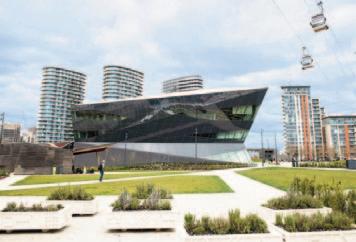


The London Plan Delivering Good Growth in uncertain times Rob McNicol, London Plan Manager 8 March 2022 London Plan 2021 On 2 March, the London Plan 2021 became part of the development plan for Greater London 10 per cent of new homes must meet the highest standards of accessibility 95 per cent of construction and demolition waste to be reused, recycled or recovered 43 safeguarded wharves
80 per cent of trips to be taken by walking, cycling and public transport by 2041
47 Opportunity 27 designated areas strategic views 50 per cent of new homes to be genuinely affordable 52,000 new homes 55 strategic per year industrial locations
The London Plan 2021 in numbers 102 policies
400 metreexclusion zone for new hot food takeaways near schools All major developments to meet net zero carbon 4,000 consultation 300 organisations and LPG current programme Status Timing London Plan Guidance Adopted October 2021 Be seen energy monitoring Public London Charter Live public engagement Running until 27 March 2022 Large-scale purpose-built shared living Running until 27 March 2022 Characterisation and growth strategies Optimising site capacity: a design-led approach Small housing developments and design codes Housing design standards Running until 20 June 2022
90-95% are written representations. About one third of appeals allowed.
Planning appeal inquiries - Rosewell procedure - implement a number of recommendations and look to be clear in terms of the process for planning appeals and this is relevant for appeals where very special circumstances on Green Belt land are involved. They are quicker.
The planning balance is about harm, benefits, weight. The government policy says to decision makers when it comes to new development in the Green Belt that it is inappropriate, it will be harmful and it should be refused unless there are very special circumstance.
Planning Appeals- Very special Circumstances
• Site already identified by the local planning authority as appropriate for being taken out of the Green belt • Local authorities accepts that Green Belt land will be needed for development • Site is at least partly previously developed land• Site is visually well containe • If local policy is out of date • If the proposed development is capable of facilitating benefit beyond residential and which goes beyond mitigating impact • Meeting housing need is a fundamental requirement but this in itself if held to be insufficient to clearly outweighs harm to the Green Belt
The Future
• Changes to the Planning System. DB does not see a trend in reducing the policy weight which is given to protection of the Green Belt and it is not a bad thing. • Growth Targets when it comes to residential development, in particular, the standard method for calculating house requirements will that change and become quite toxic. • Local Elections May 2022 • General Election • Climate Change • Biodiversity Net Gain To sum up when it comes to the prospect for Fire safety appeals for the Green Belt land you can almost Adoption pendingforget it. Early 2022 Circular economy statements Whole life carbon Mid 2022 Urban greening factor Sustainable transport, walking and cycling Air quality positive Design and Characterisation LPGPanel discussions: Couple of thoughts that you might have on the The four documents work together work together in the following way Levelling Up White Paper:
Dr Riette: Regarding housing and design - particularly design codes might stay. Robert Adams had an interesting point that design codes actually determines values. I actually think it is a much more iterative process and you cannot actually set design codes A characterisation assessment and growth strategy should be used to inform Local Plans. This feeds in to The Housing Design Standards should be for areas particularly outside London without undersmall site design codes (developed by boroughs) and site used to inform the design of residential parameters for larger sites (for site allocations and planning applications). standing viability of the case for development in the development. first instance. To make design codes to work well we need to look at resources. Roy showed us how under resource local authorities are. To do a proper design code, you need to be able to be a good client and to understand the development process. Sanmi: The level of resources is key for a lot of the delivery. Question arising from your presentation and also some of the statics we saw about the cutting of funding for planning. In living memory nobody paid planning fees with applications, now they do. No one has seen their council tax going down in the last 10-15 years. Why does it seem as though planning departments are being picked on but who is it that is picking on them? Is the local authorities making those decisions themselves? Professor Janice: A: You can look at the National Audit Office study to give some indications of the results- they looked at 2018-2018. It is the effect of residualisation. You cannot cut social care, and you do not want to cut housing, temporary accommodation. Other use services such as libraries, have already gone into an alternative forms of provision so it is really what is left to cut. We looked at motivation why council is moving into housing delivery - it is to generate income to support other services. By 2021 that has been replaced by 2 other priorities - the first one to meet housing needs and the second one is that councils are getting involved in delivery because they are completely appalled by the standards of design being offered by the private sector. Q:Talking about levelling up in housing. How do you view the levelling up agenda and what for of coming down the line in planning terms. Professor Janice: A : I come form a perspective of being London based and delivering intermediate housing first time buyers and I think that one of the key things is the we need to think about levelling up across the board. There is a real problem particularly in London about generational-intergenerational levelling up.There are a whole sort of people, generations who are frankly very prevalent in London and engage very much with planning system and generations below who don’t really engage. They are priced out of the housing market. The solution put forward is first homes with a 20% discounted home - and we know through experience that it is deliverable. Q for Sanmi - Developers by definition - everything you do is about the future. The emphasis on consultation and discussion telling you what is the appropriate design - do you think this is a great opportunity or do you think is actually a whole set of new hurdles that you come to negotiate apart of dealing with the local authorities? Sanmi:
A: We do love consultation with the community to see how receptive they are to the design.
Q: Just want to switch now because we have not talked much about the northern power house. Do you see the sort of political and planning debate in relation to the north of England as a different debate or is it actually not so different to what is going on in Oxford or Kent.
Professor Janice
A: Each local authority has its own legacy and its own issued to face - so I think in north there are issues about private sector not building and people leaving.
If you are reliant on section 106 to produce social housing or affordable housing then the viability is not there in the north. We need to move away from thinking of developers directly funding social affordable housing through section 106 and go back to using traditional taxation and then giving the local authorities the 5 year programme.
Q: Any final thoughts about the apparently increasing complexity and demands being put on planning applicants now?
Professor Janice:
A: It is becoming more complicated and it is understandable. The problem is when you are actually putting an application of 35 homes and you have exactly the same hoops as one that is over 400 and I have had that. It does not make sense and it is not proportionate. My ask is to make the system more proportionate. I am not entirely sure how you can do that but if it could be done I think that would be a a bit of a magic wand.
The London Plan
Delivering Good Growth in uncertain times
Rob McNicol, London Plan Manager 8 March 2022
Rob McNicol Rob is the team manager for the London Plan from the GLA and will give us a rundown on the London Plan.
London Plan 2021 - on 2nd of March become part of the development plan fo Greater London.
Background: • 10 months after the first funding package the was agreed between TFL and the government - long term funding for the TFL remains unresolved. • 6 months after the publication of White Paper • 3 years and 9 months after the fire at Grenfell Tower. • positively, was 14 moths after the moon activity making London net 0 by 2030.
All of these things pose major challenges for the 31

The London Plan 2021 in numbers
47 Opportunity areas
27 designated strategic views
52,000 new homes per year 55 strategic industrial locations 43 safeguarded wharves
80 per cent of trips to be taken by walking, cycling and public transport by 2041 95 per cent of construction and demolition waste to be reused, recycled or recovered
All major developments to meet net zero carbon
4,000 consultation responses
300 organisations and individuals participated in Examination in Public
London Plan 2021
LPG current programme
Status Timing London Plan Guidance Adopted October 2021 Be seen energy monitoring Public London Charter
Live public engagement Running until 27 March 2022 Running until 27 March 2022
Running until 20 June 2022 Large-scale purpose-built shared living
Characterisation and growth strategies Optimising site capacity: a design-led approach Small housing developments and design codes Housing design standards Fire safety
Adoption pending Early 2022
Mid 2022
Circular economy statements Whole life carbon Urban greening factor Sustainable transport, walking and cycling Air quality positive Air quality neutral Design and Characterisation LPG
The four documents work together work together in the following way Rob McNicol’s slides

LARGE SCALE PURPOSE BUILT SHARED LIVING LPG
Requirements for communal facilities (5 sqm, plus 1 sqm external space) Ten per cent of dwellings should be accessible Standard room size range: 18sqm to 27sqm Accessible unit size range: 28sqm to 37sqm Management plans
PLANNING FOR LONDON PROGRAMME
Gathering evidence Capturing views of stakeholders Identifying issues and options
www.london.gov.uk/what-we-do/planning/planning-london-programme
LPG find out more
LPG webpage: https://www.london.gov.uk/what-wedo/planning/implementing-london-plan/london-planguidance
Register on the engagement platform: https://consult.london.gov.uk/
planning system.
How in GLA planning navigated these uncertain waters while trying to secure the mayor’s vision for good growth.
Quick Remainder of key figures from London Plan • to build 52000 new homes every year in London - half to be genuinely affordable • All major developments to be net 0 CO2 • 80% f the trips to be sustainable by 2041. • Having an adapted London plan with clear targets gives us all a direction of travel in the planning world • Covid 19 - plans to help London recovery • Tackle other major challenges such as housing crisis and climate emergency.
LPG - current programme
• Adapted Oct 2021 - be seen energy monitoring Public London Charter • Live public engagement running until 27 March 2022 large scale purpose built share living; characterisation and growth strategies; optimising site capacity; small hosing developments and design codes; housing design standards. • Live public engagement running until 20 June 2022 Fire Safety • Adoption pending early 2022 - circular economy statements, whole life carbon; mid 2022 - urban greening factor; sustainable transport (walking and cycling), air quality positive, air quality neutral.
Design and characterisation LPG
Four pieces of guidance - separate bits of guidance but they inform each other • Characterisation and Growth Strategy LPG • Small Site Design Codes LPG • Optimising Site Capacity LPG • Housing Design Standards
Large Scale Purpose Built Shared Living LPG
• requirements for communal facilities (5 sqm + 1 sqm external space) • 10% of dwellings should be accessible • Standard room size range from 18-27 sqm • Accessible unit size range 28-37sqm • Management plans covering how the development will operate.
Coming soon to the LPG programme
• Adoption of Circular Economy Statements LPG and Whole Life Cycle Carbon LPG • Engagement after the local elections on: affordable housing and viability; industry and logistics; social infrastructure; accessibility; equality inclusion and diversity. • Developing a monitoring platform - London data hub • Launched a brand new pages that monitor delivery in each opportunity area • Opportunity to begin the conversation that will inform the next iteration the London plan - by gathering evidence, capturing people’s views and identifying the issues and options to take forward. • Current state of this is to get views of London plan through GLA talk London platform which has 60,000 users
Fire Safety London Plan Guidance
• Sets out in more detail the requirements in Policy D12 for Fire Statements and Planning Fire Safety Strategies • Sets out requirements for who needs to write Fire Statements (suitable for qualifications) • Gives information on outline applications and what to submit with which reserved matters • Puts in place requirements for justification of evacuation strategies and rigorous assessment of the number of stair cores • The Fire Statement must include a commitment that the development will
GLA Demography Research
• Expertise at the GLA monitoring and researching London’s population change over the past couple of years - help understanding trajectories and trends.
Affordable Housing On Referable Schemes • Seen a dramatic increase in the average number of affordable homes by scheme on referral applications (39% in 2019).
The London Plan does best setting a clear aspiration backed by political will and implemented through partnership with boroughs, with the development industries and with Londoners.
Questions:
Andy Catto : London Plan, like many others, is expanding in areas perhaps should not be planning. Matters the should be in building controls creeps into planning far too much. You mentioned fire safety - this is a technical matter. All buildings should be fire safe. Why is a planning matter? Every local authority wants a fire statement as a validation requirement on every application. I spent my last half hour before leaving to come here writing one for a single storey house extension. This is nonsense as it is adding workload
The next meeting of the London Planning & Development Forum
will be on Monday 6th June 2018 at 2.30pm at2.00 for 2.30pm
in person and on Zoom Discussion items likely to include Levelling-up and planning for working from home To attend please email the Hon Secretary at riette.oosthuizen@hta.co.uk
At UCL, The Bartlett SEE page 8 for the discussion items and speakers and how to come and join the conversation - free

>>>
on under resource planning staff. RM: There are few answers to this - it is to be blunt politics. The mayor has made various commitments and his view that the government’s building regulations system is not up to scratch.
Therefore, the planning system needs to do something about that.
The London Plan guidance on fire safety makes it clear that there are reasonable exceptions that can be made. We have spelled down the different schemes that can go down as reasonable exceptions route.
In regards to environment standards -the government significantly steps back and reduce the kind of requirements for high performing sustainable buildings. I think it is right that where a planning system can incorporate high standards of sustainable without creating unviable schemes. Coming back to the question - I take the point but I do not think it is necessary the case that London Plan has created a whole raft of additional requirements that are unexpected.
Finally, I would say that we made it clear we do expect the development industry to do more.
Paul Finch The Wind-up
BW introduced Paul - most distinguished journalist in architecture industry.
Thoughts about Levelling Up White Papers: -Talking about the North earlier -People used to think that depravation had something to do with class conditions. Now we substituted with geography. The Bank of England can chug up North on the stocks and pretend they bring enlightenment to the poor people from whom planning exists. Meanwhile there are parts of the North that are extremely prosperous.
The Bank of England will know that wealth creation, which is what will make the real difference about levelling up is fractal and chaotic. -I have a laugh thinking about the London Plan - it is a bit like Stalin targets for weight production in the 1930s, the more you miss the delivery the more the targets will increase. All the figures are kind of a a fantasy compared with three, four decades ago of non construction.
How are we going to make up for the fact that London population went up to 2 million. Where are the houses for the 2 million. Absolutely non existent.
Conservatives hated Peter Walker, first Secretary of State for the Environment - now the Department of Levelling Up Housing and Communities who suggested that any council tenant who lived in the home for 40 years should be given for nothing. Can you imagine the screams of horror from the Conservative party who viewed all council house occupants as idle king of leeches o the state. Even though at that time most of them were in employment, pay their rent - not true today for other reasons.
It is a weird thing in Britain as a sort of cognitive dissonance - we love the idea of becoming homeowners but on the other hand we do not actually want anybody having a house transfer that they have been paid for a long time.
The questions arrises implicit in all this is the funding for housing. Why does it have to come from developers. The level of housing we provide is a joke.
Another point about London plan in relation to Green Belt - why cannot be like listed buildings? Why can you not have Grade I - you cannot touch it, Grade II start with virtually you cannot touch it and Grade III - let’s have a discussion.
To end on a positive - I think some of the speakers showed that you do not have to be binary about this. I mean when Robert said that beauty is a really difficult thing, he said it because beauty is really philosophical and it is a dangerous territory. Where is the democratic process in all this?
There is a mendacious statement about the changes in the NPPF, where now local authorities will be able to reject things that are ‘ugly’. In the first NPPF it says that planners can reject things that are not of sufficient quality. Why introduce the word ‘ugly’? The next thing you will have commissars telling us we are going to knock down Brutalist buildings.
There is a denial of the optimistic future in which we can only speculate about the way things may become and become in a marvellous but as yet unknown way.
Brian Waters again thanked the speakers and Dentons for their hospitality; a deputy for Ian Marcus, president of CULS, did the same and all adjourned to the bar. !" We include only a selection of the slides. SEE ALL THE SLIDES HERE: https://tinyurl.com/y679eehv
You can watch the event on Youtube [in two parts – there was a tea break!]: https://youtu.be/MEfYPr31gLg and https://youtu.be/70EOZW0_nQY

The levelling up white paper & planning + implementing the London Plan
This reporttaken from: planninginlondon.com issue 121 with kind consent












